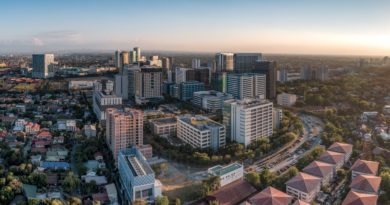Helping the Poor Turn Rags to Riches
By Reese Fernandez-Ruiz as told to Ruth Manimtim-Floresca
I was exposed to poverty as a child having been raised by a missionary mother and visiting different churches. I saw poverty for what it is and thought we should not really have levels in society. Everyone is just trying to get by somehow. Even if you’re rich or poor, you’re trying to achieve something for your family.
During my university days, I would go to different areas in Payatas and Tondo and would see the poverty around there as well. It’s just beyond me how some people who are really smart and driven cannot have the opportunities to make their lives better when, in fact, they have all that it takes to do so but they just don’t have the opportunities to get there.
My involvement in immersion programs through the Ateneo de Manila University, where I studied Business Management, and different organizations like Gawad Kalinga, inspired me to see how I can help out in some way and how a systemic solution can be integrated.
I’ve learned that it’s not just about getting exposure and knowing what’s out there then just being thankful for what you have. It’s about going out there, seeing what you have, and thinking “How can I contribute to make this situation better?”
Right after college, I went to Ateneo School of Government and worked in the department handling youth leadership and social entrepreneurship.
 Finding a purpose
Finding a purpose
Sometimes, we just forget that we’re all in one world and we’re all related somehow. But that if we work towards providing better opportunities for other people, it would ultimately make our environment, our world, and future, a better place.
My work right now as President and Founding Partner of Rags2Riches is about providing secure livelihood to artisans all around the Philippines. We create eco-ethical home and fashion accessories and operate primarily in Metro Manila. In addition, we source materials like tinalak, abaca, and jute from different indigenous communities from all over the country. We try to modernize or provide modern design direction for indigenous and traditional textile.
The idea for Rags2Riches came from its nine co-founders. I think, it’s because of an inspiration, what somebody said, somehow. And so, this idea became as good as it is because everyone contributed to it. That’s the beauty of it. We all came from different backgrounds: one is a Jesuit priest, some work for multinationals, and I was the fresh graduate.
I became “the face” of RIIR because I’m the youngest in the group and I decided that I want to make this something that I could do for my life. Of course, the other co-founders, who believe in our mission, are helping out as board of directors but they also had their own careers. I decided to continue that mission and to give life to it and to make sure it’s continuous. Sayang naman if it gets cut off in the middle as a really nice project that could have been a nice business.
I believe that it’s only when somebody in the team, or everyone in the team, commits to a certain extent that something can be sustainable and successful. But it’s only when someone really devotes his or her life to it that it will really go on for a long time. All of the co-founders felt that way also and I’ve been blessed to be encouraged to go towards this direction.
RIIR started in 2007 with an initial starting capital of P10,000. We were registered in January 2008 and had to put in our own money to incorporate. I was then a part-time volunteer and there was someone mainly doing admin jobs. We started growing the team late 2008.
Establishing sustainability
RIIR works by paying community members the labor cost. Whether we sell the products or not, their labor costs are sure. Ours is a for-profit social enterprise. We’re comprised of several co-founders, board of directors, and also the cooperative of the community in Payatas.
So, by definition, when we have profit sharing in the future, they will also be part of it. It would be nice in the future if there is; but the goal, first and foremost, is to provide sustainable livelihood, not necessarily to have profit for people. Me? I just receive a salary for what I do.
At first, it was difficult to foster the trust of the community members because they’ve been victims of so many social injustices before. So it’s really hard to just show up and say we’re going to change the whole situation. We didn’t do that. We just went there and listened to them and exchanged ideas. I think it really comes from a place of understanding of where they’re coming from.
Their motivation to keep working is the secure income and the savings program where 20% additional income goes to their savings directly. They have their own passbooks with CARD Bank. It’s the document that has their name on it and they know that this can bring them out of poverty. We also have life and livelihood skills trainings for our community artisans. Last, but not the least, is the sense of community we have. It’s not worker is to boss relationship at all. The workers can come to us freely and talk to us about their problems.
I think it’s the key. Because when you really talk to people and you treat them as your family and your friends, you won’t do anything that will hurt them or make life unfair for them.
Forging partnerships
We have been very fortunate to have collaborations with Rajo Laurel, Amina Aranaz-Alunan, Oliver Tolentino, and soon, Kenneth Cobonpue. It’s a blessing to find amazing people who really want to help. It was just a matter of showing them that we can provide products with excellent quality since, of course, that would be their concern as well. The products would have to speak for themselves. And the cost must have integrity.
When we tied-up with these famous designers, the value of the products became higher in people’s eyes. They gave that effect to the whole product but, at the same time, we want to go beyond that. It can’t just be an endorsement that gets the sales.
Our clients are mostly 25-45 year olds who are well educated and well traveled. They are into eco-fashion or want to advocate and stand for something. They are local and foreign women of style, substance, and sustainability.
Looking ahead
RIIR, and myself, has already been recognized by several award-giving bodies, which allow us to share this pride and story to the world. We’re very happy with them but it’s never been a motivation. It’s just a good pat on the back; a good encouragement that we’re on the right track and we’re doing the right thing. So the awards are ways for us to spread the news to more people. Because of them, we are able to sell to the international market, talk to more people abroad, and partner with more designers.
My husband of almost three years, also a social entrepreneur and one of the co-founders of RIIR, and my parents are very supportive. I think it matters a lot that I don’t have issues with my family when it comes to this and that contributed a lot to the success of RIIR.
A few years from now, I’d probably be building a family and staying in RIIR either as part of the team, or as a customer, or somebody else. I can see myself still in the social entrepreneurship field. I think this is really the field where I would continue to grow.
MY MONEY LESSONS
How to Become a Social Entrepreneur
Reese shares tips to young people who are also interested in becoming social entrepreneurs:
- Try out different things. Volunteer and look at different organizations and places because you’ll never really know what you want to do until you try it. It’s not a cognitive, but a very hands-on process. You will know if you feel alive in one organization and you’ll want to do that for the rest of your life.
- Be very grounded and humble. When you want to help the poor, don’t expect that everybody will thank you and love you. It’s not how it is; it’s not how it should be. It should always be a partnership. You are not the one going there to help them. You are helping each other. A lot of people leave communities because their expectations are so high.
- Don’t waste a lot of time trying to figure things out. When you find what you’re passionate about, try to do it even in small steps. You can never have enough money, enough talent, enough time before you start something. Start doing it especially if it can solve a social problem. You can help more people and have more years ahead of you to do a lot more things.
- Be market-driven. When you help communities, understand the kinds of products that they make and help market them to the international world or to the local industry. Look around and see what’s out there then bridge those with what the communities can do.
- Don’t be afraid to collaborate . It’s always good to share ideas, and to partner with people who can help you and whom you can help. That’s going to make your work a lot faster.





